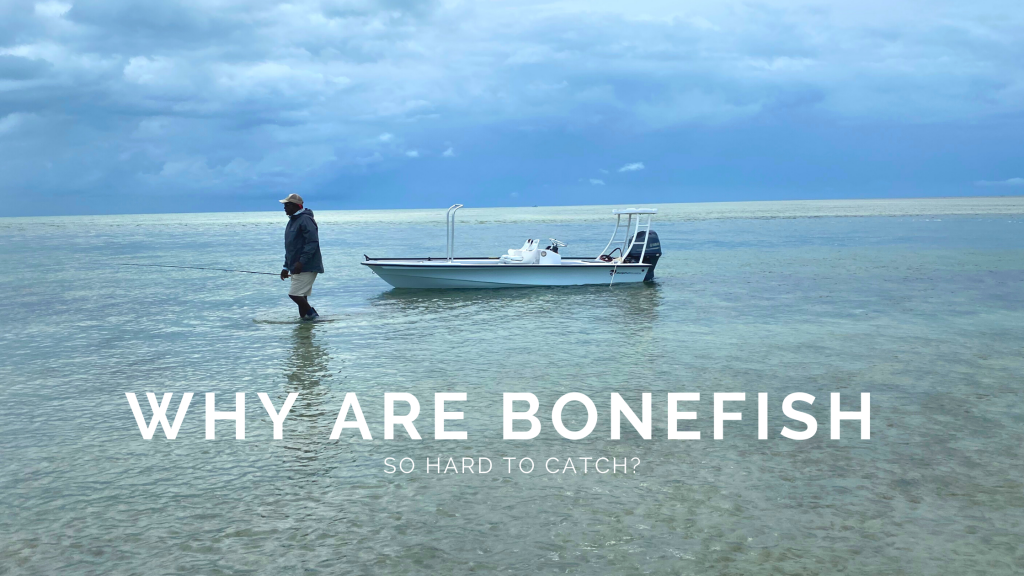Bonefishing is guaranteed to test your patience and skill unlike any other type of fishing adventure. Not only are bonefish naturally good at hiding, but they’re also elusive and incredibly stealthy. From making sure that you aren’t wearing bright colors or covered in distinctive smells, to timing, measuring, and presenting your casts perfectly, there’s a lot that must be done to successfully nab one. If you’ve never gone bonefishing before or have yet to reel this impressive species in, you may be wondering why they’re so tough to catch.
Bonefish Are the Gray Ghosts of the Flats
Untrained eyes can easily overlook bonefish. This is why it’s important to have a reliable, seasoned guide who knows exactly what to look for. Bonefish have bright, silver scales on their lower sides that deliver a mirror-like reflection of the flat bottom. Their backs are blue-green with dark-colored streaks, such that the topmost portion of their bodies easily blends into grass-covered areas. In most environments, they’re perfectly camouflaged. Younger bonefish have dark cross-bands on their backs that make them slightly easier to spot, but these markings gradually fade and obscure. By the time bonefish are just three inches long, these bands are barely visible at all. The overall design of a bone’s body allows it to swim and feed undetected by both natural predators and anglers with limited bonefishing experience.Every
Bonefish is as Unique as a Snowflake
There’s also the fact that every bonefish is unique. You can’t expect the same behavioral characteristics from every bonefish you encounter. Each one will fight, feed, and even look differently. The more observant you become; the easier it will be to detect these differences. With time and experience, you’ll be able to tell when your tackle needs to be upsized or downsized to better suit your prey. You can fine-tune and tailor your approach to suit solo travelers and small groups. One of the best ways to improve your bonefishing skills is by learning how to spot the alpha. Although bonefish frequently travel and feed alone, you may spot them in schools of approximately four to six fish, with the leader at the front.
They’re Incredibly Easy to Spook
One of the most appealing attributes of bonefish is their impressive speed, reaching up to 40 mph. These fish can live 23 years or more, and some can get as long as 31 inches, and weigh as much as 14 pounds. They don’t get this big by being easy prey. They have lots of physical and behavioral characteristics that make them hard to spot and difficult to lure in. Not only are they great at camouflage, but they’re also highly suspicious. If you don’t land your fly just right, make too much noise, or invade their environment with pervasive smells and colors, they’ll spook, and quickly move on their way.
Bonefish Are Insatiable Eaters
Bonefish are very opportunistic feeders, and live in an “eat or be eaten” world. This means that if you’re capable of presenting your fly just right, a bone will likely eat it, regardless of how it looks. In fact, you’ll notice that some bonefish flies don’t resemble what these fish actually feed on. Research performed in the Florida Keys found 106 forage foods in the stomach of 200 voracious bonefish. They certainly aren’t picky. Thus, fly presentation and casting skills are significantly more important than fly selection. If you can put your fly in front of a bone without him noticing you, you’ll definitely get his attention.
Bonefishing is Sportfishing
A trip to the flats to catch bonefish is unlike the lazy days many anglers spend relaxing shoreside with their poles. Sure, you’ll spend plenty of time quietly waiting and watching for your prey, but you’ll also have to use the trained eye and reflexive skill of a hunter. Not only is it important for anglers to display the same level of stealth that bones exhibit themselves, but they’ll also have to account for wind, sun glare, and other environmental challenges. The good news is that despite their reputation for being elusive, big bones are not impossible to haul in. So put yourself out there, practice your casting, increase your experience, learn from your mistakes and feel the unmatched exhilaration of reeling in the fabulous gray ghost of the flats.








